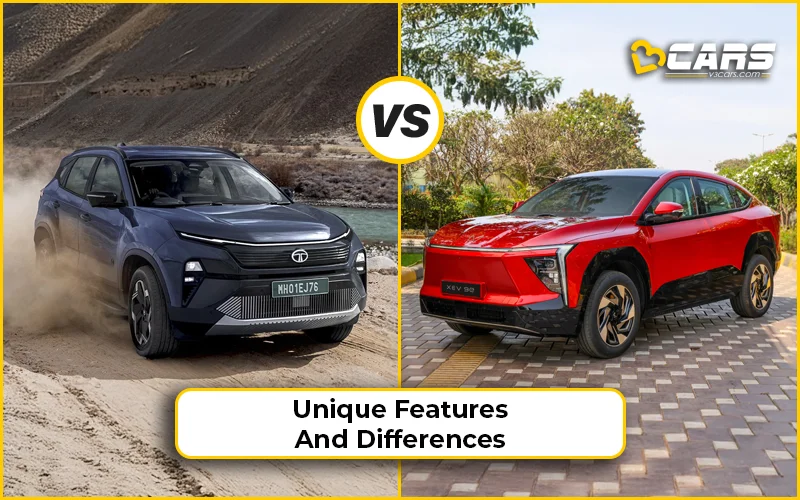Tata Harrier EV vs Mahindra XEV 9e Detailed Comparison — Top 25 Differences & Unique Features Of Each Car Base & Top Model
The Tata Harrier EV and the Mahindra XEV 9e, both bring a bunch of features we have never seen before. If you’re wondering how they compare with each other in this regard, then this article is for you. Here, we’ll compare the Mahindra XEV 9e and the Tata Harrier EV to find out what unique features they offer. Where the other car is lacking, we’ll highlight those differences as well. For instance, the Harrier EV has higher torque, then we’ll also highlight the torque output of the XEV 9e for instant comparison.

Here are the top unique feature differences between the Tata Harrier EV and Mahindra XEV 9e.
|
|
|
|
|
|
|
|
|
|
|
|
|
|
|
|
|
|
|
|
|
|
|
|
|
|
|
|
|
|
|
|
|
|
|
|
|
|
|
|
|
|
|
|
|
|
|
|
|
|
|
|
|
|
|
|
|
|
|
|
|
|
|
|
|
|
|
|
|
|
|
|
|
|
|
|
|
|
|
|
|
|
|
|
|
|
|
Also Read: Tata Harrier EV 2025 — Variant-wise Expected Price
Scoop: Mahindra XEV 9e 4WD In The Pipeline To Compete Against Harrier EV 4WD
Helpful Links:
Fuel Cost Calculator for Cars – Know your monthly fuel expense based on usage and mileage
Car On-Road Price Calculator – Convert ex-showroom to on-road price for any city
Sell Used Car Online – Enter your car and contact details to get an instant price estimate and book a free inspection with our partner network


0 Comments
Tata Cars in India
Sierra
₹11.49 lakh*
*Ex-showroom priceHarrier EV
₹21.49 - ₹28.99 lakh*
*Ex-showroom priceAltroz
₹6.30 - ₹10.51 lakh*
*Ex-showroom priceCurvv
₹9.66 - ₹18.85 lakh*
*Ex-showroom priceCurvv EV
₹17.49 - ₹22.24 lakh*
*Ex-showroom pricePunch EV
₹9.99 - ₹14.44 lakh*
*Ex-showroom priceHarrier
₹14.00 - ₹25.25 lakh*
*Ex-showroom priceSafari
₹14.66 - ₹25.96 lakh*
*Ex-showroom priceNexon
₹7.32 - ₹14.05 lakh*
*Ex-showroom priceNexon EV
₹12.49 - ₹17.19 lakh*
*Ex-showroom priceTigor EV
₹12.49 - ₹13.75 lakh*
*Ex-showroom priceTiago EV
₹7.99 - ₹11.14 lakh*
*Ex-showroom pricePunch
₹5.50 - ₹9.30 lakh*
*Ex-showroom priceTiago NRG
₹6.68 - ₹8.10 lakh*
*Ex-showroom priceYodha Pickup
₹9.51 - ₹10.71 lakh*
*Ex-showroom priceYodha Single
Cabin 4x4
₹10.24 lakh*
*Ex-showroom priceTigor
₹5.49 - ₹8.74 lakh*
*Ex-showroom priceTiago
₹4.57 - ₹7.82 lakh*
*Ex-showroom priceUpcoming Tata Cars
Harrier Petrol
₹15.00 - ₹26.00 lakh*
*Expected PriceExpected Launch Dec 2025
Safari Petrol
₹15.50 - ₹27.00 lakh*
*Expected PriceExpected Launch Dec 2025
Punch Facelift
₹6.30 - ₹10.50 lakh*
*Expected PriceExpected Launch Jan 2026
Sierra EV
₹19.50 - ₹24.00 lakh*
*Expected PriceExpected Launch Sep 2026
Avinya
₹35.00 - ₹40.00 lakh*
*Expected PriceExpected Launch Jun 2027
Altroz EV
₹13.40 - ₹14.40 lakh*
*Expected PriceExpected Launch Feb 2028
Blackbird
-
*Expected PriceExpected Launch Jun 2030
Latest Tata Cars Videos
Hyundai Venue vs Tata Nexon Sub Rs. 11 Lakh Battle | Which Car Is More Value For Money?
Hyundai Venue vs Tata Nexon Sub Rs. 12 Lakh Battle | Which Car Is More Value For Money?
Hyundai Venue vs Tata Nexon Sub Rs. 9 Lakh Battle | Which Car Is More Value For Money?
Tata Magic Express CNG: Highway Fuel Efficiency Test | V3Cars
Hyundai Venue vs Tata Nexon | Sub Rs. 8 Lakh Battle | Which Car Is More Value For Money?
Tata Harrier.ev 75 AWD Real-world Range Test w/ Efficiency & Drive Impressions
Tata Altroz CNG Mileage Test & Drive Impression | Better than Swift CNG?
MG Windsor EV vs Tata Curvv EV Sub Rs. 19 Lakh Battle | Which Car Is More Value For Money?
Tata Punch vs Renault Kiger | Sub Rs 8 Lakh Battle | Which Car Is More Value For Money?
Tata Punch vs Hyundai Exter Sub Rs. 10 Lakh Battle | Which Car Is More Value For Money?
Harrier EV Important Links